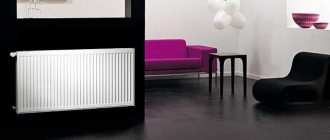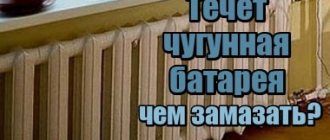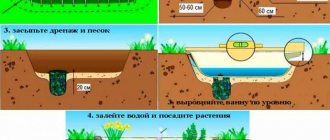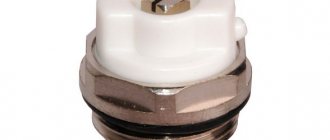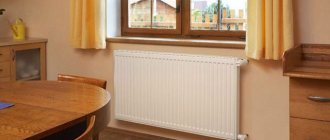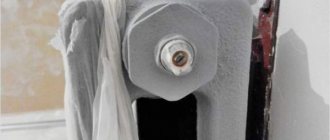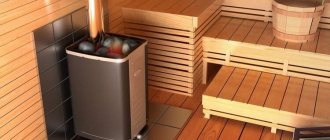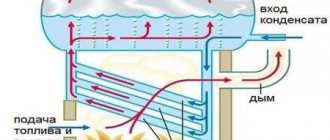Many people can lift this weight. But only film actors can stretch it like accordion bellows.
How much can an old-style cast iron battery weigh? There is no average value for the simple reason that there are a huge number of models in use on the heating market, differing not only in appearance, but also in technical parameters. But I know the answer, and I’m ready to share with you.
When purchasing radiators for an entire house, it is necessary to know their weight in order to calculate the carrying capacity of the vehicle and the number of loaders.
Answer for the impatient
For those who do not like to read for a long time, I will immediately indicate in the table the weight of a section of an old-style cast iron battery, and I will also write how much modern analogs made of aluminum and bimetal weigh:
| Illustration | Parameter |
Cast iron standard:
Non-standard - from 3.7 to 14.5 kg/section | |
Aluminum.
| |
Bimetallic.
|
I foresee your question regarding weight - why is there no accurate data on cast iron? After all, you need this value to determine whether you can remove the old 10-section radiator from your apartment or house with your own hands?
The issue of weight is far from idle - you need to calculate your strength before agreeing to work on storing old radiators.
The thing is that in operation there are models of different series, identical in purpose, but different in weight. In addition, there are a lot of models on the market that differ in size and shape from each other. Today there are more than two dozen traditional cast iron models alone, and there are almost no counting of designer floor models.
The photo shows 15 models of cast iron radiators, the weight of each varies significantly.
Calculation of the actual weight of heating devices
Now let’s calculate the weight and number of sections for cast iron heating batteries that provide a heat output of 2 kW. Let's start with the old model - MS-140, whose power is 160 W from one edge. To gain 2000 W, you need to divide them by 160 W, we get 12.5 sections, rounded 13 pieces. The total weight of the finished batteries will be 13 x 7.12 = 92.6 kg, and with water - 112 kg. That is, for every kilowatt of heat transfer there is 112 / 2 = 56 kg of radiator mass filled with coolant.
Using the same method, we will calculate the specific gravity of the cast iron batteries presented above and find out how far the technology for manufacturing such heaters has gone. Let's put the results in the table:
| Radiator brand and model | Power of 1 fin, W | Number of sections providing 2 kW of heat | Weight with water, kg | What is the weight of heat transfer of 1 kW, kg | Price of a 2 kW radiator, cu. e. |
| Viadrus KALOR 500/70 | 70.3 | 29 | 139 | 69.5 | 582 |
| Viadrus Bohemia 450/220 | 110 | 19 | 234 | 117 | 1487 |
| Demir Dokum Nostalgia 500/200 | 163 | 13 | 155 | 77.5 | 679 |
| Retro Style Anerli 560/230 | 189 | 11 | 223 | 111.5 | 2526 |
| EXEMET Modern 600/100 | 102 | 20 | 100 | 50 | 640 |
| EXEMET Classica 500/176 | 145 | 14 | 158 | 79 | 1076 |
Comment. From the presented table you can clearly see how much modern cast iron costs for heating apartments and private houses. For comparison: the price of an MS-140 section is 8.3 USD. e., and a whole radiator for 2000 W – 108 cu. e. Such prices limit the number of homeowners able to buy designer products.
Based on the analysis, the following conclusions can be drawn:
- The thermal power of a heating device practically does not depend on its mass, only on its surface area.
- Manufacturers produce both massive and lighter models of cast iron batteries that are attached to walls.
- The heaviest cast iron radiators are made in the “retro” style, while the lighter ones are made in the “modern” style.
- If we compare new heaters from different brands with “accordion” heaters in terms of coolant volume, it becomes clear that this indicator has hardly changed.
- The massiveness is ensured by the thickness of the cast iron walls. This means that the thinnest walls come from products from the Turkish brands EXEMET and Demir Dokum, and the thickest from the Russian manufacturer Retro Style.
- Please note that the weight of the cast iron affects the final price of the product. The heavier the product, the more expensive it is.
For reference. Vintage models of heating devices, which have a large mass, are usually offered in a floor-standing version. That is, the 2 outer sections are equipped with legs, and in long cast iron heaters additional supports are placed in the middle. For information on installing designer batteries, watch the video:
How much do cast iron standard ones weigh?
The common feature that unites them is the material of manufacture, namely cast iron. When we mention cast-iron batteries, the classic cast-iron accordion radiators immediately come to mind, which were installed and still serve well in:
- Preschool and school educational institutions;
- Medical institutions (hospitals and clinics);
- In all residential premises (dormitories, apartments, private houses and cottages);
- State and public organizations.
The classic example of an accordion battery can be found everywhere.
The overwhelming majority are the MS-140 or MS-90 model. There were no other mass production models observed in the past period.
To be fair, I note that in past years, the Minsk-110, NM-140, NM-150, R-90, RKSh and others models were produced in small series. Currently, they are not produced, and their scope of application was limited to regions close to the manufacturer.
Famous movie characters had to wear radiators of the MS-140-500 series.
So what is the weight of one section of an old-style cast iron battery? What value does the factory manual contain? And here it is impossible to answer with one number, since the dimensions of the section play a role.
For example, the cast iron battery of the MS-140 series has 2 varieties (center distance):
- 300 mm;
- 500 mm.
Accordingly, if we are talking about MS-140-300, then the average weight of one fin of a cast-iron battery is 5.7 kg. And if we are talking about MS-140-500, then one such section will show 7.1 kg on the scales.
Weight depends on the dimensions of the section.
The MS-90 series is also quite common. In comparison with the 140 series, the weight of the old-style cast iron battery section is 6.5 kg at 500 mm.
For models MS-90 and MS-140, the difference lies in the shallower section depth.
Let's summarize : we have determined 3 different weights of the most common series (MS-90 and MS-140) - 6.5 kg, 5.7 kg and 7.1 kg, respectively. Can these values be considered final?
No, and here's why.
Regulatory document regulating the production of cast iron radiators
The existing standard (GOST 8690-94) describes the main parameters and dimensions of manufactured radiators. As for the weight of the sections, this standard contains a specific gravity value of 49.5 kg/kW.
This standard applies to block and cast iron heating radiators intended for use in heating systems with coolant temperatures up to 150 °C (423 K) and excess operating pressure up to 0.9 MPa (9 kgf/cm2).
To dismantle such a monster, it must first be sawed.
In fact, the manufacturer must comply with the specified values, but the weight of a separate section is not regulated by GOST. In practice, this is expressed by the fact that the products of different enterprises differ in weight.
As of the beginning of 2021, I know the products of several enterprises that produce MS-140 radiators, their modifications and products of our own design:
- Foundry and Mechanical Plant (Ukraine, Lugansk);
- Heating equipment plant (Republic of Belarus, Minsk);
- Boiler and radiator plant (Russia, Nizhny Tagil);
- "Descartes" (Russia, Novosibirsk);
- "Santekhlit" (Russia, Bryansk).
Let's look at the product range and determine how much cast iron batteries from different manufacturers weigh.
Nizhny Tagil
The manufacturer issues a passport for each product indicating the number of sections.
The company produces 4 models from cast iron:
| Product | Exact weight of the cast iron section of the radiator, kg |
| MS-140-M-300 | 5,40 |
| MS-140-M2-500 | 6,65 |
| MS-90 | 5,475 |
| T-90 M | 4,575 |
Manufacturer from Belarus
"Barelief" is a single-channel sectional radiator of modern design.
This manufacturer offers 9 types of cast iron radiators:
| Product | Exact weight of the cast iron battery fin, kg |
| MS-140M | 6,7 |
| B-Z-140-300 | 5,4 |
| 2K60P (two-channel sectional) | 3,7 |
| 2K60 | 5,1 |
| 2KP100-90-500 | 5,5 |
| 1K60P-60x500 (single-channel) | 3,84 |
| 2KPM-90X500 | 4,6 |
| 2K60P-300 | 3,7 |
Santekhlit
The company has been idle since last year, but its products are still sold in stores.
Let's find out how much one rib of a cast iron battery weighs - the former "Lubokhonsky Iron Foundry":
| Product | Exact weight, kg |
| MS-85 | 4,45 |
| MS-140M | 7,1 |
| MS-140-300 | 6,1 |
| MS-110-300 | 4,45 |
| MS-110-500 | 5,6 |
Weight of sections of cast iron radiators from different manufacturers
To understand how much a section of a cast iron battery from different companies weighs, you need to familiarize yourself with the range they produce:
- Nizhny Tagil Boiler and Radiator Plant . This manufacturer provides a passport for each of its products, which indicates the number of sections. The company offers 4 cast iron models. At the same time, the exact weight of the section is: for radiators MS-140-M-300 – 5.4 kilograms; MS-140-M2-500 - 6.65 kilograms, MS-90 and T-90 M, 5.475 and 4.575 kilograms, respectively.
- Belarusian "Bas-relief" . It produces mainly single-channel sectional radiators, made in a modern design. This manufacturer produces 9 models of cast iron batteries, in which the exact weight of the fin ranges from 3.7 kilograms (products 2K60P-300) to 6.7 (MS-140M).
- Russian "Santekhlit" . Now the enterprise has been stopped, but its products are still sold in the retail chain. The exact weight of the battery fins ranges from 4.45 kilograms (models MS-85 and MS-110-300) to 7.1 kilograms (MS-140M).
How much do non-standard cast iron weigh?
Having found out how much radiators of common series can weigh, let’s look at the parameters of non-standard products. I will say right away that there is no unity here either: both the mass and the price vary.
Three-channel floor-standing radiator from a French manufacturer.
One section of the Guratec Apollo 795 model weighs 13.5 kg. Sold in sections of 7 with a total weight of 94.5 kg, so several people are needed during unloading and installation.
The appearance of the classic cast iron radiator is undergoing changes, subject to the influence of fashion trends
The “cheaper” Czech manufacturer Viadrus produces Kalor 500×160 cast iron radiators whose section weight is 5.6 kg.
Imported products undergo mandatory certification for compliance with GOST, but the weight of the section is not taken into account during testing.
Important point: how much water is in the cast iron section
One section of this design alone will hold 5 liters. We are talking about the MS-140A brand. Ten cast iron sections will hold 50 liters of water. For comparison: an aluminum radiator, its smallest section alone holds very little, only 0.3 liters of water. And the largest section is no more than a liter.
Many people believe that cast iron batteries are something from a retro series; they are no longer produced. But if you notice that such radiators serve well in hospitals, clinics, schools and gardens. They are everywhere, and some owners, on the contrary, are trying to exchange new models for the usual cast iron ones.
About the creators of heat
Manufacturers of bimetallic or steel batteries blame the cast iron “veterans” for thermal inertia. There is some truth in their statements. The heat transfer of cast iron radiators ms 140 is low, but this is the case when a disadvantage turns into an advantage. Any bimetallic battery cools down within a matter of minutes after turning off the heating; a cast-iron radiator will “keep” the heat for at least another thirty minutes. The production of these products is established in Novosibirsk, Nizhny Tagil and the village of Lyubokhna (Bryansk region). The heating equipment plant in Minsk also produces a cast iron radiator MS 140, the characteristics of which are almost identical to Russian models. This is due to the fact that the GOST according to which this product is produced is the same for all manufacturers in the former Soviet republics. Accordingly, the manufacturing methods are practically no different, which in turn gives rise to the same flaws in the finished product. For example, the Russian cast iron radiator MS 140 technical characteristics, which require its installation in residential premises, like its foreign counterparts, has a very unpresentable appearance. By the way, this is one of the reasons why such radiators have somewhat lost their position in the heating equipment market.
The weight of the battery has also become a common disadvantage for all products of this type, regardless of the country of manufacture.
Despite this, the Belarusian MS 140 500 cast iron radiator, the characteristics of which are most in demand, is in steady demand in the Russian market.
Features of the MS-140-500 radiator
Cast iron radiators MS-140 with a center distance of 500 mm are designed for heating buildings of any purpose, from private residential buildings to industrial and production buildings. They have good heat transfer and resistance to aggressive coolants. Cast iron “accordions” stubbornly do not want to leave the heating equipment market, since they are considered the most unpretentious type of radiators.
The main advantage of cast iron batteries is their long service life. Cast iron reluctantly reacts with water and aggressive compounds, resisting corrosion well. The top layer, protected by primer and paint, is also not susceptible to it. Even in the absence of external protection, cast iron practically does not deteriorate or become thinner. It gets to the point that in some cases these radiators can outlast the building itself in terms of service life.
The heat output of MS-140 cast iron radiators with center distance ranges from 140 to 185 W per section. This is a pretty decent indicator, which allows cast iron to successfully compete with other types of heating batteries. Today, cast iron batteries are produced by many domestic factories and are not going to leave the shelves of plumbing stores.
What are the advantages of cast iron radiators MS-140-500?
- Resistance to aggressive coolant - centralized heating systems do not spare even the most durable modern radiators. Cast iron practically does not react with caustic and aggressive compounds;
- Large internal capacity - thanks to this, radiators almost never become clogged or clogged. Also, the internal volume helps reduce hydraulic resistance;
- Long service life - manufacturer's warranty reaches 10-20 years. As for the actual service life, it is up to 50 years and even more, you just need to properly care for the batteries and tint them on time;
- Long-term heat retention - if the heating is turned off, cast iron will retain and release heat for a long time, heating rooms and rooms;
- Affordable cost - the price for cast iron radiators MS-140-500 starts at 350-400 rubles per section (depending on the manufacturer).
Let's list a few disadvantages:
- Heavy weight is perhaps one of the most important disadvantages. One section weighs over 7 kg, which is why the weight of a 10-section battery is over 70 kg;
- Difficulty in installation - if you can install aluminum or steel radiators yourself, then two or three people will have to work on a cast-iron radiator. In addition, for fastening to the wall you need good, durable fasteners (and the walls themselves should not crumble under the weight of the batteries);
- Lack of resistance to high pressure - cast iron batteries are intended for use as part of autonomous heating systems (installation in low-rise buildings connected to centralized systems is allowed).
We can also highlight as a disadvantage of cast iron batteries MS-140 their high inertia - a lot of time passes from supplying coolant to warming up the system.
MS-140 cast iron radiators can be used as part of autonomous and centralized heating systems with a maximum coolant pressure of up to 9-10 atmospheres . The coolant temperature can reach +120-130 degrees - cast iron remains resistant to such temperature overloads. The main thing is not to subject it to strong impacts, otherwise it may break.
MS-140 radiators can be used in systems with natural and forced coolant circulation. The system can be open or closed - cast iron can work in any conditions. The main thing is that the heating parameters do not exceed the values specified in the passport data. The difficulty in operation is caused only by the need for regular maintenance - monitor the condition of the paint coating and prevent the formation of pockets of corrosion.
What does battery weight matter?
You need to have information about how much a cast iron heating radiator weighs for a number of reasons. For example, if batteries are purchased for installation throughout a private household, you need to calculate the carrying capacity of the vehicle transporting the heating devices, and you must also decide on the number of loaders who will carry them into the house.
For clarity, you can compare the weight of cast iron radiators of outdated models and modern analogues made of other materials:
- one section of standard cast iron batteries with a center distance of 500 mm weighs 5.5 - 7.2 kilograms, and with a center distance of 300 millimeters - from 4.0 to 5.4 kilograms;
- the weight of the fins of non-standard cast iron heating appliances ranges from 3.7 to 14.5 kilograms;
- the aluminum battery section weighs 1.45 kilograms with an interaxle spacing of 500 millimeters, and 1.2 kilograms with 350 millimeters;
- bimetallic devices with an interaxial distance of 500 millimeters weigh 1.92 kg/section, and with 350 millimeters - 1.36 kg/section.
When carrying out repairs and replacing heating equipment in a house, it is important for its owners to know how much an old cast-iron radiator weighs in order to decide whether it will be possible to take the old multi-section radiator outside on their own, since it is necessary to calculate their own strength. But there is no such data.
The reason is that there are different models in use. Moreover, they have the same purpose, but different weights. In addition, devices that differ in size and variety of shapes are sold on the domestic market.
Today, for example, there are more than several dozen names of traditional cast iron batteries, and it is difficult to count models made in a designer style. At the same time, such a parameter as the weight of one section of a cast iron radiator is very different.
Characteristics of cast iron heating radiators
During the assembly process, the sections are connected by spools , and the joints are carefully sealed to avoid leakage. There are single-channel and double-channel sections.
Depending on how many sections the products consist of, they have different widths and heights. Before choosing the width of the radiator, analyze the area of the room requiring heating, the number of windows and the thickness of the walls.
So, if enhanced heating of the room is required, choose a battery with a large number of sections. The height of the batteries ranges from thirty-five centimeters to one and a half meters.
Important! You should also pay attention to the depth of the product - how the heating devices can match the interior of the room depends on this indicator.
The depth of the radiator ranges from fifty to one hundred and forty centimeters. To mount a cast iron radiator, you need strong brackets that must be securely and carefully secured to the wall. The batteries are hung under the window, placed in such a way that they recede a short distance from the wall. However, there are battery models that are equipped with legs.

